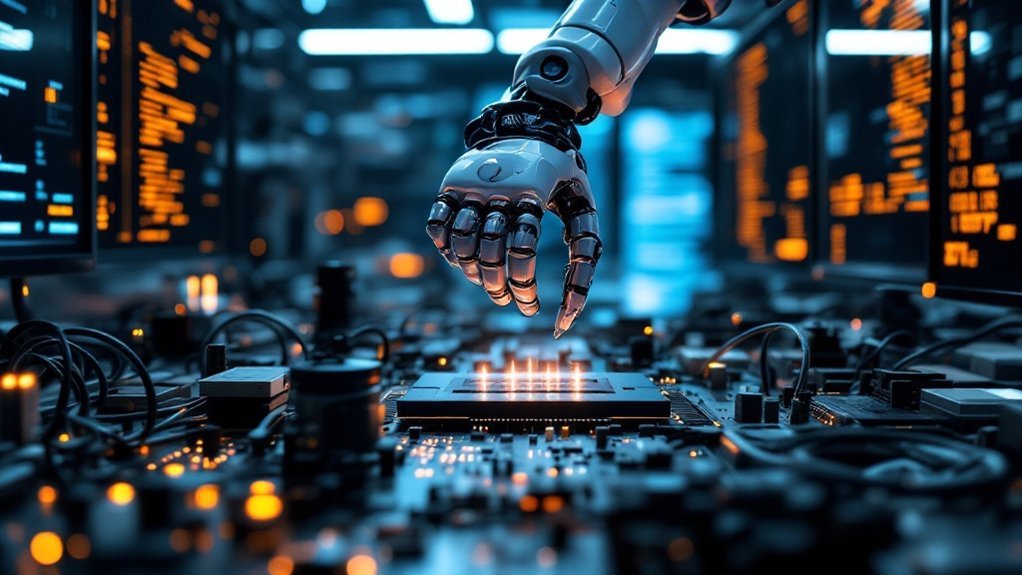You're using AI to prioritize tasks, which analyzes deadlines, dependencies, and importance to create a customized list that helps you focus on high-impact activities first. You'll get a prioritized list based on factors like urgency and time sensitivity. AI tools optimize task management, reducing manual effort and increasing efficiency. As you investigate AI task prioritization, you'll uncover how it adjusts to your work patterns and preferences, enhancing your productivity and workflow, and that's just the beginning of what you'll find.
Key Takeaways
- AI analyzes deadlines and dependencies to prioritize tasks.
- Machine learning predicts task urgency and adjusts priorities.
- AI considers effort and importance in task prioritization.
- Real-time adjustments optimize task schedules and workflows.
- Predictive analytics forecast project completion and potential risks.
AI Task Prioritization Basics

You're about to explore the world of AI task prioritization, a revolutionary tool for managing your workload.
You'll use AI algorithms to prioritize tasks based on deadlines and other factors. These algorithms analyze deadlines, dependencies, and task importance to create a prioritized list.
By using AI task prioritization, you'll focus on high-impact activities first, ensuring you meet your deadlines.
AI algorithms process tasks and organize them based on predefined criteria, helping you manage your workload more efficiently.
This approach helps you prioritize tasks effectively, making the most of your time.
Prioritization Logic Criteria
Effectiveness in task management relies heavily on a clear understanding of prioritization logic criteria. You'll use AI algorithms to prioritize tasks based on deadlines and other factors.
| Criteria | Description | Impact |
|---|---|---|
| Deadlines | Task due dates | High |
| Effort | Time and energy required | Medium |
| Importance | Task value and urgency | High |
| Dependencies | Task relationships | Low |
You'll focus on high-value tasks with near deadlines, using AI-driven task prioritization to enhance your schedule.
Machine Learning Adaptive

How do machine learning models adjust to prioritize tasks effectively?
Machine learning models use real-time task prioritization to adjust to changing conditions. Machine learning enables AI to analyze vast amounts of data, determining which tasks are most urgent and important.
As you work, AI algorithms learn from your behavior, predicting the best working hours for task completion. This responsive approach allows AI models to continuously update task priorities in real-time, ensuring they remain aligned with project requirements.
Through machine learning, you can achieve flexible task prioritization, enhancing productivity and efficiency. It's a key aspect of AI task prioritization.
Here are some specific ways AI achieves this:
- Automated task prioritization: AI algorithms can automatically prioritize tasks by analyzing deadlines, dependencies, and task importance. This helps users focus on high-priority items and manage their time effectively.
- Intelligent scheduling: AI can optimize schedules by considering team members' availability, workload, and project timelines. It can suggest the best times for meetings, deadlines, and task assignments to maximize productivity and minimize conflicts.
- Predictive analytics: AI can predict outcomes and offer recommendations to improve efficiency, ensure timely completion of tasks, and enhance overall productivity. This involves analyzing data and adapting to changing conditions.
- Dynamic task prioritization: In multitask learning, AI models can dynamically prioritize tasks based on their difficulty. This approach ensures that more challenging tasks are given more resources and attention, leading to better overall performance.
- Learning from behavior: AI tools can learn your preferences over time, prioritizing tasks and delivering recommendations based on your habits. This personalization helps in organizing, prioritizing, assigning, tracking, and completing tasks efficiently.
Integration Tool Options
AI-powered tools like Todoist, Trello, and Asana are now integrating AI features to enhance task prioritization, making it easier for you to manage your tasks.
You can use AI integration to simplify your workflow, and tools like these can help with task prioritization using AI. They offer flexible scheduling, which enables you to allocate resources efficiently.
With these tools, you can centralize task management and improve visibility. You'll be able to mechanize tasks and reduce manual effort, allowing you to focus on high-priority tasks.
This integration will help you work more efficiently and effectively.
Real Time Adjustments

As you manage tasks, flexible prioritization is crucial to staying on track. You'll make real-time adjustments to task priorities based on emerging risks and shifts in project requirements.
This responsive prioritization allows you to continuously evaluate changing conditions, such as resource allocation. AI facilitates this process, adjusting task priorities in real-time based on updates in deadlines and dependencies.
You can enhance resource allocation, ensuring tasks are aligned with available capacity and deadlines, and make real-time adjustments to maximize efficiency.
Personalized Task Feedback
What sets effective task management apart is the ability to receive feedback that's customized to your unique work style. You get customized task feedback from AI algorithms that analyze your work habits and preferences.
Key factors include:
1. Effort estimation
Effort estimation is a critical process in project management that involves predicting the time and resources needed to complete a specific task or project. It helps in planning, scheduling, and allocating the necessary resources, ensuring that projects are completed within the defined scope, time, and budget constraints.
2. Task priority adjustment
AI task management tools can prioritize tasks by analyzing deadlines, dependencies, and urgency. They can automatically suggest which tasks should be completed first based on factors like importance, time sensitivity, and workload, ensuring you focus on what matters most.
3. Energy level alignment
While not explicitly mentioned in the sources, energy level alignment can be inferred through the personalized task management provided by AI. AI task managers can adapt to your work habits over time, suggesting tasks that align with your energy levels and productivity patterns. For example, AI can analyze the time you usually spend on specific kinds of tasks or observe deadlines and completion rates to provide intelligent suggestions.
AI task prioritization helps you enhance productivity by providing feedback adapted to your needs, ensuring you're focusing on the right tasks at the right time.
AI Driven Productivity

You're now working with a system that simplifies your workflow, using AI to drive productivity. This AI-driven productivity improves your tasks' prioritization, saving you time and effort.
AI algorithms analyze data to streamline task prioritization, ensuring you focus on high-impact activities. By automating task categorization, you can reduce project delays.
You'll experience improved task management as AI learns your work habits and rearranges tasks accordingly, increasing your overall productivity.
With AI-driven productivity, you can efficiently manage your tasks and deadlines, achieving more in less time.
Task Management Strategies
Most task management strategies rely on effective prioritization to increase productivity. You'll use task prioritization to align tasks with your goals. Here are some key strategies:
Evaluating Task Complexity
Evaluating the complexity of tasks is crucial for effective prioritization. This involves assessing the time and effort required to complete each task. For instance, the Pomodoro Technique suggests dividing tasks into 25-minute intervals, but you may need to adjust the duration based on the task's complexity.
Assessing Dependencies
Assessing dependencies is another important aspect of task prioritization. Identify tasks that need immediate attention due to their urgency and the potential negative consequences if not completed on time. This includes tasks with high-priority dependencies that rely on other pieces of work being completed first.
Integrating with Existing Tools
Integrating with existing tools, especially those powered by AI, can significantly enhance task management. AI task managers can automatically schedule your day based on task priorities and deadlines, adapt to your work habits, and provide intelligent suggestions.
AI algorithms can automatically prioritize tasks by analyzing deadlines, dependencies, and task importance. This helps users focus on high-priority items and manage their time effectively. Additionally, AI can optimize schedules by considering team members' availability, workload, and project timelines, and suggest the best times for meetings and task assignments to maximize productivity and minimize conflicts.
AI task management systems can also predict potential delays, bottlenecks, and resource shortages by analyzing historical data and current trends, enabling proactive decision-making and risk management to keep projects on track. Moreover, AI can generate detailed reports and insights on task progress, team performance, and project status, which helps managers make informed decisions and identify areas for improvement.
To make the most of these tools, it is important to set clear objectives and customize AI settings to align with your overall goals. This allows the AI to prioritize, schedule, and allocate resources effectively, ensuring that the most important tasks receive the necessary attention.
Frequently Asked Questions
What Is the Science Behind Artificial Intelligence?
You're exploring AI, it's a computer science branch that creates intelligent machines, and you're learning how they work, using algorithms and data to perform tasks that typically require human intelligence and reasoning.
How Does AI Help in Repetitive Tasks?
You use AI to streamline repetitive tasks, it helps you by updating statuses, reminding you of deadlines, and suggesting work times, freeing up your time for more important activities quickly.
What Are the Pros and Cons of AI in Project Management?
You're evaluating AI's project management pros, like efficiency and cost savings, against cons, such as potential bias and integration challenges, to make an informed decision about its implementation.
Conclusion
You'll enhance your productivity by leveraging AI task prioritization, which adjusts to your needs and work style. It's a transformative innovation for managing tasks, as you'll make real-time adjustments and receive tailored feedback. By integrating AI-driven tools, you'll refine your workflow, achieving more in less time, and that's what it's all about – getting things done efficiently.
